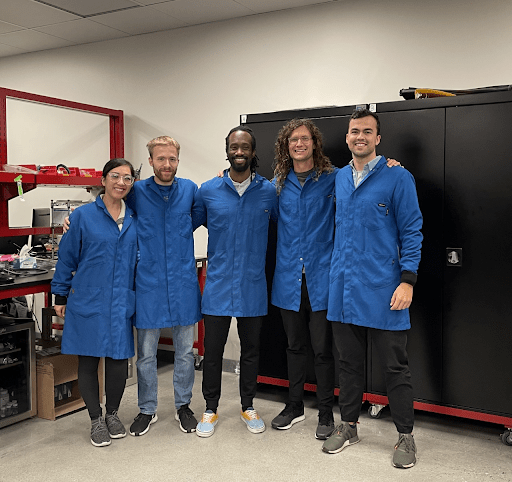David Mackanic Ph.D. ’20 founded Anthro Energy, a startup attempting to change the way batteries are made, after a breakthrough in his research on lithium-ion conductors. Mackanic plans to use his batteries as a safer power source for medical devices, prosthetics and wearable electronics.
To understand Mackanic’s contribution, it is useful to think of a battery, at its most basic level, like a sandwich. Two sides — the cathode and the anode — make up the bread of the sandwich. They have different electrical potentials — one gives away its excess charge, another receives them — and the transfer of electrical charge releases energy which we can access through electronic devices. However, in order for the charge to travel from one side to the other, there needs to be a conductive filling (electrolyte).
There are many kinds of these battery fillings; most lithium batteries use a potentially-flammable liquid filling. Solid, ceramic electrolytes are safer and more conductive, but more brittle. Mackanic’s polymer-based electrolyte decouples this trade-off between durability and conductivity by creating a battery that can be folded, stretched and pulled countless times without changing its properties.
The Daily sat down with Mackanic to learn more about his innovation, Anthro Energy and where he’s looking to take the company.
This interview has been lightly edited for clarity.
Flexible battery in the form of watch wristband (Photo courtesy of David Mackanic)
The Stanford Daily [TSD]: How would you describe Anthro Energy?
David MacKanic [DM]: Anthro Energy is an advanced battery materials company. We make a new generation of polymer electrolytes that enables the creation of lithium-ion batteries that are safe and high-performing. The batteries also have unique mechanical properties that allow them to be structural. We’re using this technology to create batteries that are flexible and deformable to power wearable electronics and medical devices. Ultimately, we aim to use these advanced battery materials to help create safe energy storage for a wide range of applications.
TSD: While lithium-ion batteries are good for energy storage, there are many limitations and potential hazards associated with them. How is Anthro’s battery different from traditional lithium-ion batteries?
DM: Normally, the electrolyte is a liquid material. And this liquid material has two issues: they are flammable, dangerous and quite weak. So it’s prone to mechanical fracture. By replacing the mechanically fragile liquid with this mechanically robust polymer, we not only enhance safety but also enhance the mechanical resilience of the cells, which allows us to bend the cells and deform them while they’re operating.
TSD: The problem has been around for a while now, especially with the rise of interest in electrical storage systems and wearable electronics. What’s Anthro’s unique contribution to this space?
DM: There’s a number of great companies working on all aspects of this problem. Some people work on ceramic electrolytes, however, there are issues with ceramics. The processing is quite difficult to scale up and the mechanical properties are also quite brittle.
We’ve been able to engineer both interfaces and additives to push for higher performance. So basically, we have this electrolyte that has good conductivity, it’s tough, it’s strong, it’s highly processable. It also functions as an adhesive and creates nice interfaces between all the battery layers, which is also important for performance, safety and structural integrity. Typically, as you increase the mechanical strength, the conductivity will decrease; there’s a natural trade-off.
With our core technology, we can create this highly tough elastomeric battery where it’s stretchable and tough, and it doesn’t tear easily.
TSD: Scaling up from the lab must have been a challenge. What is your pathway towards commercialization so far?
DM: I should be clear that our product is not formally commercialized: we have demo kits available, and we have products in the market, but nothing that a normal consumer can go out and buy.
In terms of the journey so far, there’s kind of the laboratory phase. And then we had this innovation transfer phase that was supported by Stanford. Then we had a prototype development phase that was supported by both the Department of Energy and some venture capital money. This enabled us to validate the performance and run more robust experiments. It allowed us to work with customers to get feedback on the products, and to understand if what we were making was meeting their needs.
TSD: What are the biggest challenges you’ve encountered so far?
There are consistency and scale-up issues, especially as it relates to the supply chain, so sourcing all of the right materials, ensuring their quality and making sure that we can repeatedly and consistently create high-performance devices. But just with all of the things that have been happening logistically in the world, it seems like there’s always something that we can’t get our hands on; we’ve been able to engineer workarounds around that problem. It’s not a showstopper. But it is quite challenging when you’re trying to create a consistent product that you can sell to users, and that you can show the world.
On the organizational front, as a startup, we kind of have had to have many people wear many hats, which is exciting, but also definitely a challenge. And there are some growing pains associated with that.
TSD: What are the next steps?
DM: We’re focused on identifying good customers, and then working with the ones we already have to move to a production phase. We’re going to build a small prototyping facility so we can create commercial quality cells in-house. We’re going to work with contract manufacturers to demonstrate the high volume production of ourselves, and we’re gonna ultimately enter the qualification and certification process to prove that our cells are safe and stable and acceptable for use in these next generation of devices that we’re powering. We’re also looking for more people to join the team.
